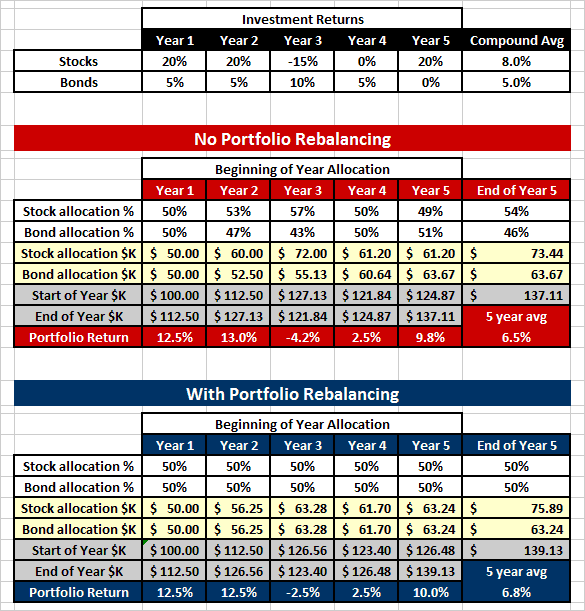Financial Planning Blog
 Rebalancing Your Portfolio (Part 2)
Rebalancing Your Portfolio (Part 2)
Like going to the dentist every six or twelve months, people are encouraged to rebalance their investment portfolios or 401K accounts. (It seems like most people would rather go to the dentist.) In Part 1, we looked at what rebalancing means, and why it is important. Below, the impact of rebalancing is demonstrated a simple example. After that, a couple practical questions are dealt with.
To illustrate, let's expand upon the simple example started in Part 1. The investor begins with a $100,000 portfolio allocated 50% to bonds and 50% to stock. Over a five year period, stocks average an 8% annual return, but the returns range from -15% to +20%. Over the same period bonds average 5%, with returns ranging from 0% to +10%.

First thing to note is how the stock/bond allocation oscillates over time. In year three, the portfolio has become significantly more risky (57% stock, instead of the target 50%), and as a result the portfolio that is not rebalanced suffers a much larger negative return in that year than the rebalanced portfolio. Conversely, in year five, the untended portfolio has become slightly more conservative than planned, and there is a corresponding drag on performance in that year.
With no rebalancing of the portfolio, the investor averages 6.5% over the five years, ending up with a bit over $137,100. However, when the portfolio is rebalanced at the beginning of every year the investor averages 6.8%, and ends up with about $139,100. The investor earns about 5% more over the five years. This may not seem like a huge difference, but over time it will add up. And, when you are rebalancing across more asset classes than just stocks and bonds (e.g. international vs U.S. stocks, small cap vs large cap stocks, TIPs vs traditional bonds), you have more opportunities to benefit from rebalancing.
How often should you rebalance your portfolio?
Like so many things in finance, there is no one right answer to this question. You need to weigh the value of your time and the transaction costs (e.g. commissions and taxes) with the potential benefit derived from rebalancing. Generally, once or twice a year is deemed sufficient, but it really depends on how much the market is moving. A time based approach, once or twice a year at a preset time, is simple and relatively easy to follow. A more complex approach is to monitor your investments more frequently (e.g. monthly) and gauge whether investments have deviated from predetermined limits. Many investment managers advocate this approach to boost potential returns.
Other tips
Most 401K plans seem to have pretty good tools to make rebalancing easy. Once you figure the tools out, it is simple. There are no tax impacts and no generally no other transaction costs to concern the investor.
If you are working within an IRA or other tax advantage account, you don't need to worry about the tax impact of trading, but the task is usually more time consuming than in your 401K plan. And, you do need to worry about the transaction costs of buying and selling your funds. Using no transaction fee mutual funds may eliminate the commissions and fees, but may cost you more in the long run, if this forces you to use funds with higher expense ratios. If you are working with a discount broker, using low cost, passively managed exchange traded funds (ETFs) may be a cost effective solution to minimizing your overall portfolio expenses.
In taxable accounts, rebalancing can be somewhat expensive. Not only do you need to be mindful of commissions, but selling positions that have gone up may cause you to realize taxable capital gains. One way to avoid this is to rebalance your investments across multiple accounts. Look at your taxable and tax-favored investments as one unified portfolio and ideally use a tax-favored account for rebalancing. None of your accounts will match your target allocation exactly, but when added together they are in balance.
Conceptually, none of this is extremely difficult. However, unless you are working with a 401K or another account with tools that makes rebalancing easy, it does take some work-and the effort increases as you make your portfolio more complex. Spreadsheet skills will certainly come in handy for the DIY investor.
Obviously, this is not how everyone likes to spend their evening, which is why many investment portfolios go untended. Given the importance of your investment portfolio in meeting your future objectives, it often pays to seek out the help of a competent financial planner who can help you develop an asset allocation plan. And then let that planner assist you in keeping your portfolio in balance and on track over the years.
Next page: Disclosures




